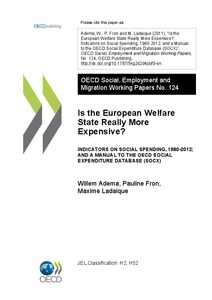Is the European welfare state really more expensive?
"Part I of this paper first presents information on trends and composition of social expenditure as in the OECD Social Expenditure database for the years 1980 – 2007. Over this period, public social expenditure as a percentage of GDP, on average across OECD, increased from 15.6% to 19.2%. Publi...
| Main Authors: | , , |
|---|---|
| Institution: | ETUI-European Trade Union Institute |
| Format: | TEXT |
| Language: | English |
| Published: |
Paris
2011
OECD |
| Subjects: | |
| Online Access: | https://www.labourline.org/KENTIKA-19136115124919543979-is-the-european-welfare-state-.htm |
| Summary: | "Part I of this paper first presents information on trends and composition of social expenditure as in the OECD Social Expenditure database for the years 1980 – 2007. Over this period, public social expenditure as a percentage of GDP, on average across OECD, increased from 15.6% to 19.2%. Public pension spending (6.4% of GDP) and public health expenditure (5.8% of GDP) are the largest social spending items.
Part I also presents social expenditure indicators that account for the effects of the tax system as well as indicators on private social expenditure. Including both of these features alters country rankings by level of social spending and leads to a convergence of spending-to-GDP ratios across countries. Based on this broader measure net total social expenditure as a percent of GDP at factor costs in 2007 was highest in France and Belgium, at 30% of GDP, and between 22 and 28% of GDP in Austria, Canada, Denmark, Finland, Italy, Japan, the Netherlands, Portugal, the United Kingdom and the United States.
Part II of this paper presents the OECD SOCX Manual. It starts with a discussion of methodological, classification and data issues regarding the gross spending items as in SOCX. It also looks at the methodological aspects of measuring net social expenditure, and presents information on how relevant estimates were derived. Accounting for the effect of the tax system and private social expenditure leads to greater similarity in social expenditure-to-GDP ratios across countries and to a reassessment of the magnitude of welfare states. After accounting for the impact of taxation and private benefits, social expenditure amounts to over 30% of GDP at factor cost in Belgium and France; social expenditure also ranges within a few percentage points of each other in Austria, Canada, Denmark, Finland, Italy, Japan, the Netherlands, Portugal, the United Kingdom and the United States." |
|---|---|
| Physical Description: | 131 p. Digital |

